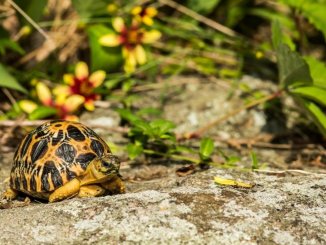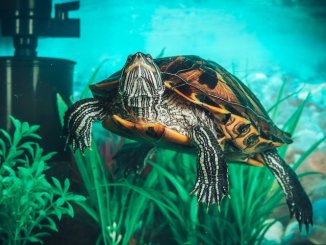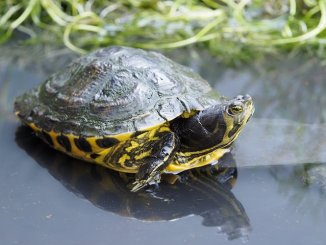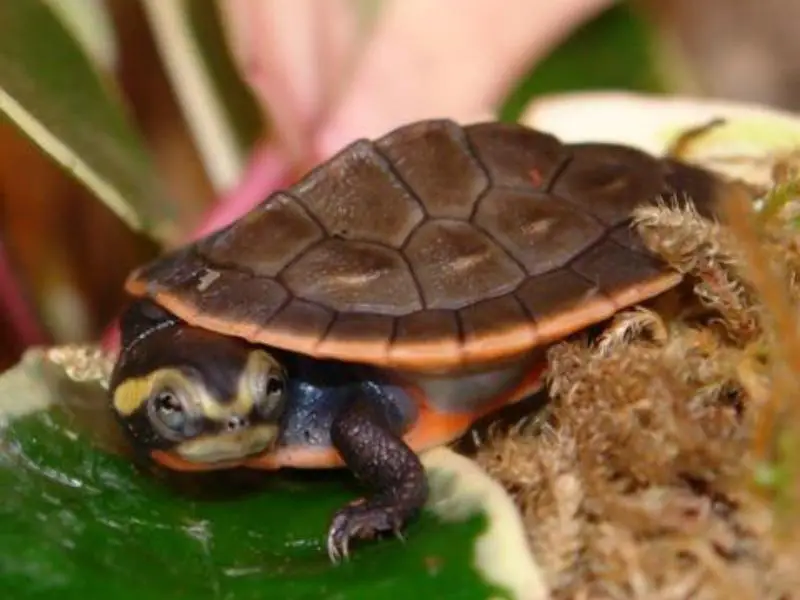
The pink belly sideneck turtle has a pink, red, or orange belly with a shell that’s gray, beige, taupe, or coffee. The juvenile turtles are characterized by a ring around their outer shell which is usually orange or red.
These water-loving turtles, originating from Australia and Papua New Guinea, retreat into their shells by pulling their heads in sideways, which gives the turtles their name.
The pink belly sideneck turtle is an easy-going and friendly pet but should only be kept by intermediate-to-expert keepers because of the high level of care required.
Pink Belly Sideneck Turtle Overview
| Common name | Pink belly sideneck turtle or pink-bellied side-necked turtle |
| Scientific name | Emydura subglobosa |
| Natural habitat | Tropic areas with large sources of freshwaters such as ponds, swamps, or lakes in Papua New Guinea and Australia |
| Adult size | 5–16 inches |
| Average lifespan | 30–50 years |
| Diet | Omnivores that naturally feed on mollusks, crustaceans, aquatic insects, algae, and sponges |
| Housing | A 20–60-gallon tank with fresh or brackish water and a gradient temperature of 66–95°F. The tank should contain dense aquatic vegetation and slopes or logs |
| Experience level | Intermediate–experienced |
Origin
The pink belly sideneck turtle (Emydura subglobosa) originates from Australia and Papua New Guinea in tropical areas covered with large bodies of freshwaters such as lakes, ponds, swamps, and rivers.
Australia has stopped exporting the pink belly sideneck turtle due to the species’ rarity. The turtles have been successfully captive-bred in the United States which has increased the species’ population and earned the turtles popularity among hobbyists and turtle keepers.
Appearance and Behavior
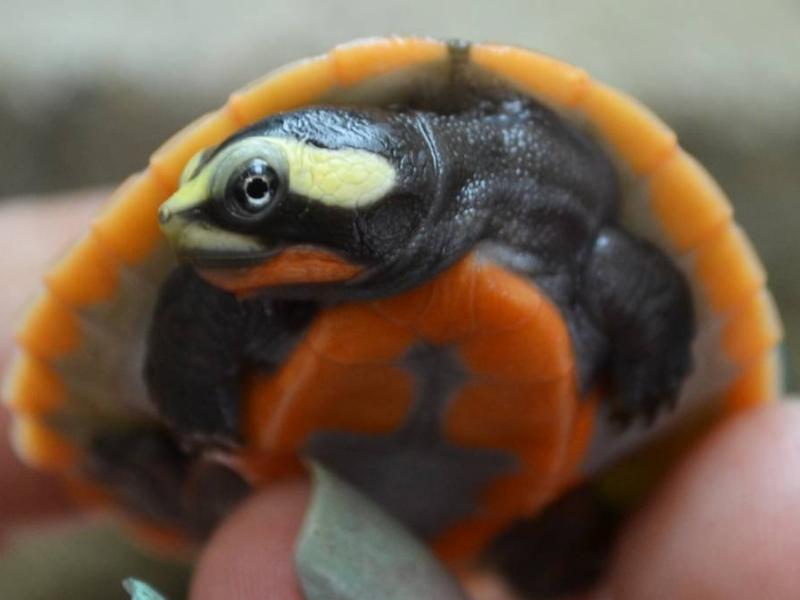
Pink belly sideneck turtles have a flat shell with the typical gray, brown, and beige colors found on most turtles. The turtle’s name refers to the bright pink, red, or orange coloring on the turtle’s belly.
Pink belly sideneck turtles have gray bodies with two yellow-cream stripes running from the tip of their nose into the middle of their irises. The turtles also have two prominent yellow whiskers on the chin.
Juvenile turtles have a bright-colored ring around their outer shell, which can be viewed from above and fades as the turtles mature.
Male turtles have longer and thicker tails than females, while female turtles’ overall size is larger than males’.
Size and Lifespan
Adult pink belly sideneck turtles are generally between 5 and 10 inches long. Female turtles are typically 10 inches long but can reach up to 16 inches. Male turtles are usually 5 to 7 inches long at full size.
In captivity, pink belly sideneck turtles live for up to 30–50 years if the tank is kept in good condition and the turtles are fed a healthy diet.
Temperament
Pink belly sideneck turtles are friendly and sweet-natured turtles that spend the majority of their time in the water, occasionally basking out of the water. These turtles become stressed when handled and should only be handled when necessary. This species will bite if it feels threatened.
These turtles have a calm and peaceful temperament and do well in a community tank. This species is not territorial, but it shouldn’t be kept in the same tank as American snappers or musk turtles because pink belly sideneck turtles are seen as prey by the larger turtles.
Housing Pink Belly Sideneck Turtles
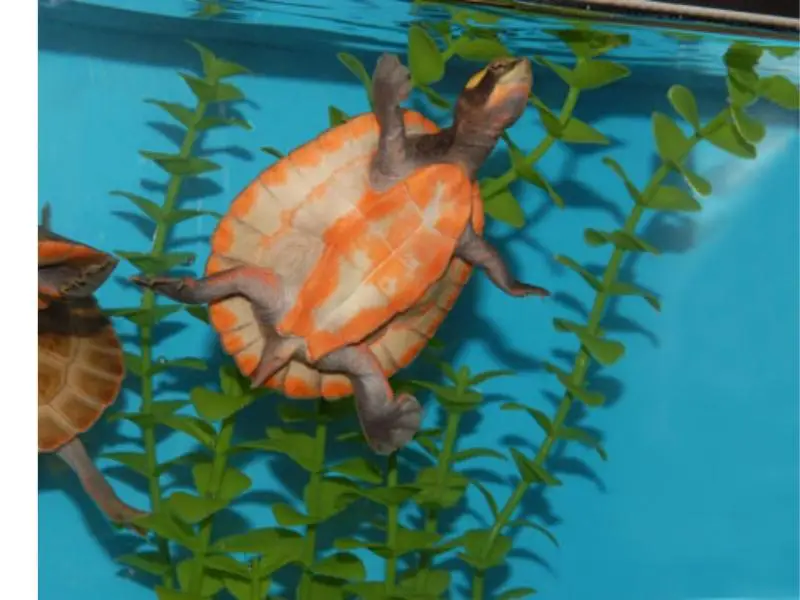
Keep a pink belly sideneck turtle in a large, well-lit aquarium to mimic its natural habitat of tropical freshwater areas. The turtle is happiest and healthiest when it has plenty of room to swim around, with natural decoration and dense vegetation.
Enclosure size
Pink belly sideneck turtles need a minimum tank size of 20 gallons when they are 4 inches long. As the turtle grows, the tank size will need to increase by 10 gallons for every extra inch the turtle grows. The tank will need to be increased by at least 10% for every additional turtle added to the tank.
Maintain extra height above the water level in a tank setup to accommodate a basking slope or log for the turtle.
Lighting
A pink belly sideneck turtle tank that is set up outside, out of direct sunlight, provides enough lighting for the turtle. However, an indoor setup needs additional lighting.
Add a 75-watt UVB bulb above the indoor tank with a cycle of 12 hours on and 12 hours off. Place the bulb above the tank rather than inside it.
Temperature and Humidity
A pink belly sideneck turtle should be kept in a tank with gradient heating, in the temperature range of 66–80°F.
Use a halogen lamp to keep the basking area temperature warmer, at 92–95°F. Monitor the temperature gradient with a built-in aquarium thermometer and a basking thermometer.
The turtle doesn’t require a specific humidity level as long as the temperature is correct.
Substrate and Decoration
Line the tank with rocks larger than the pink belly sideneck turtle’s head or with rinsed aquatic or river sand to prevent the turtle from choking and to prevent bacteria buildup. Don’t use gravel because the turtle may choke on it.
Add decorations like logs, rocks, natural or artificial plants, and turtle ramps, but don’t create small spaces in which the pink belly sideneck turtle can get stuck. The turtle is highly active and will forage around the decoration and substrate to find spaces to hide and bask.
Place a slope in the tank to create a shallow-water basking area as well as a dry basking area on the warmer side of the tank.
Cleaning
Replace 25% to 50% of the water in the tank once a week to keep the pink belly sideneck turtle healthy. A high-quality water filter system and a dechlorinator large enough to cycle two times the amount of water in the tank are recommended to keep the water clean.
Any water that is safe for humans to drink is safe for the turtle to live in.
The aquarium will only need cleaning once a month if the correct filter is used. Clean the tank by adding ¼ cup distilled white vinegar to 1 gallon of water and scrub the tank with a clean sponge. Remember to clean out the filter and any decorations in the tank before adding fresh water back into the tank.
Place the turtle in a separate container during cleaning, making sure to handle the turtle carefully.
Pink Belly Sideneck Turtle Care
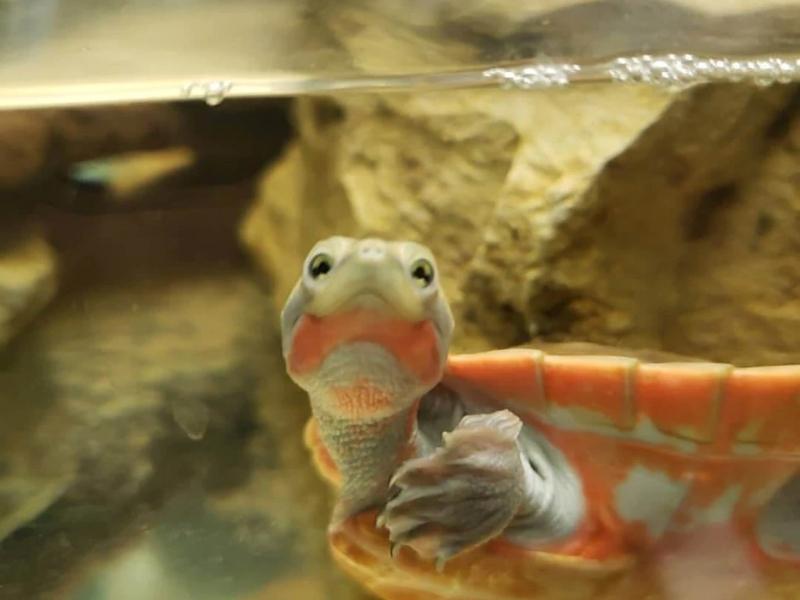
Pink belly sideneck turtles need an intermediate-to-experienced keeper to provide the habitat and dietary standards needed to keep the reptile healthy and happy.
Food and Water
In the wild, pink belly sideneck turtles eat a predominantly-carnivore diet made up of mollusks, insects, and crustaceans, and the turtles occasionally feed on sponges, algae, and periphyton.
Feed these turtles foods that mimic their natural diet, including meats such as fish, turtle pellets, bloodworms, and crickets. Also, feed the turtles vegetables like lettuce, carrots, and turnip greens once a week.
Avoid feeding a pink belly sideneck turtle shrimp because the shrimp doesn’t provide any nutritional benefits and is highly addictive.
Feed a pink belly sideneck turtle based on their age, following these general guidelines:
- Hatchlings: feed them only turtle hatchling pellets once a day
- Juveniles: feed them a variety of crickets, pellets, worms, and vegetables every other day
- Adults: feed fully mature turtles a mix of fish pieces, worms, and crickets three or four times a week, and a helping of vegetables during one of the feeding times
Feed the turtle by adding the food to the water in the tank to allow the pink belly sideneck turtle to forage and hunt. Mimicking the turtle’s natural feeding pattern will help it keep its instincts and feel secure in the contained environment.
Handling
Pink belly sideneck turtles should be handled as little as possible because these turtles are happiest when left alone to swim. Only handle the turtles for short times when cleaning out the tank and remember they may bite when feeling threatened.
Common Health Issues
Pink belly sideneck turtles are prone to numerous health issues if they are not cared for correctly. Signs of disease include overly smooth shells, misty and dull eyes, lethargy, and reluctance to eat.
Common health issues that affect pink belly sideneck turtles include:
- Metabolic bone disease (MBD) — caused by a lack of UVB light and vitamin deficiencies and causes deformations on the turtle’s shell and a weakened skeletal structure. MBD is treatable with antibiotics and calcium supplements
- Respiratory issues — caused by vitamin deficiencies and dirty water that contains bacteria. Signs of respiratory issues include lethargy, wheezing, excess mucus, and reluctance to eat. Treatment requires veterinary care
- Vitamin A deficiency — caused by malnourishment or a lack of UVB lighting. Signs of vitamin A deficiency include bulging eyes, lethargy, boils, and loss of appetite. Avoid vitamin A deficiency by feeding the turtle a well-balanced diet and providing enough UVB light in 12-hour cycles
- Shell rot — caused by fungal or bacterial infections and creates cracks in the turtle’s shell. Veterinary care is needed to treat cases of shell rot
- Parasites — (such as roundworms) commonly found in pink belly sideneck turtles. Symptoms include diarrhea. Seek veterinary care to check for internal parasites
Brumation
Mature pink belly sideneck turtles don’t hibernate, but they may go into brumation — a period of dormancy during the colder months — when the temperature drops below 50°F.
Brumation is evident when the turtle starts slowing down and becoming inactive and is believed to be necessary for the health and regulation of hormones in turtles.
However, brumation is dangerous in captive turtles and should be overseen by an experienced reptile keeper or veterinarian.
Breeding

The turtles breed on their own without intervention as long as there are males and females in the tank. Female pink belly sideneck turtles breed two to four times a year, usually every second year. The females dig holes on land to lay 7 to 14 eggs on average, which normally occurs between August and October.
The gestation period of pink belly sideneck turtles lasts between two to four months. Once hatched, hatchlings are independent of the female within an hour and are left to find the water themselves.
Care for hatchlings by keeping them in a smaller 20-gallon tank with a warmer temperature of around 70 to 80°F. Feed hatchlings more protein than adults using high-quality turtle pellets once a day. Move the turtles to an adult tank when they reach 4 inches long.
Choosing and Buying a Pink Belly Sideneck Turtle
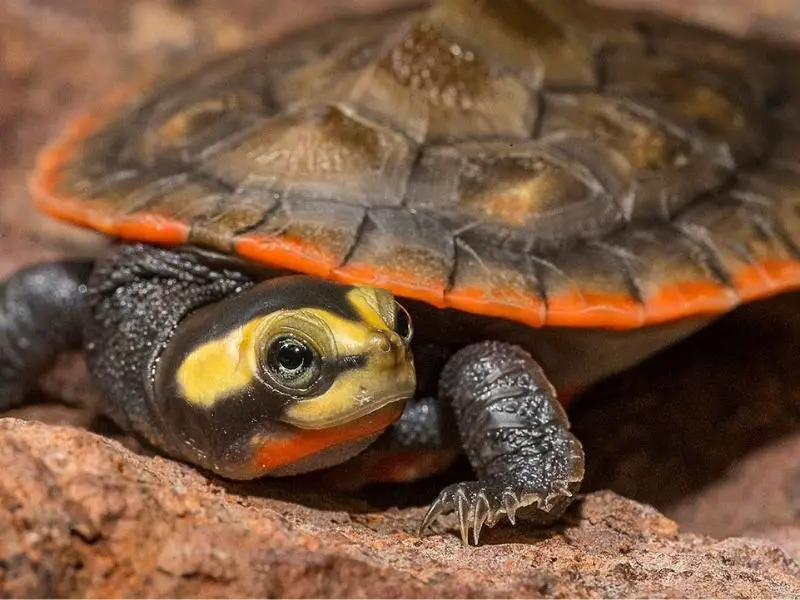
On average, pink belly sideneck turtles cost between $60 and $120 from reputable breeders or pet stores. New-born hatchlings are usually around $60–$79, while adult turtles around 2–3 years old are priced between $80–$120.
Certain types of pink belly sideneck turtles, such as albinos, can cost up to $1,000. Note that, in the United States, a permit is required to legally keep this turtle.
In North America, captive-bred pink belly sideneck turtles are most common. Australian-born pink belly sideneck turtles are no longer exported and are much less common.
When choosing a pink belly sideneck turtle, look out for signs of ill health such as pyramiding and flaking shells, dull and swollen eyes, lethargy, and lack of appetite.
Buy a captive-bred pink belly sideneck turtle rather than a wild-caught turtle, because a wild turtle could have illness and disease that will shorten its lifespan.

